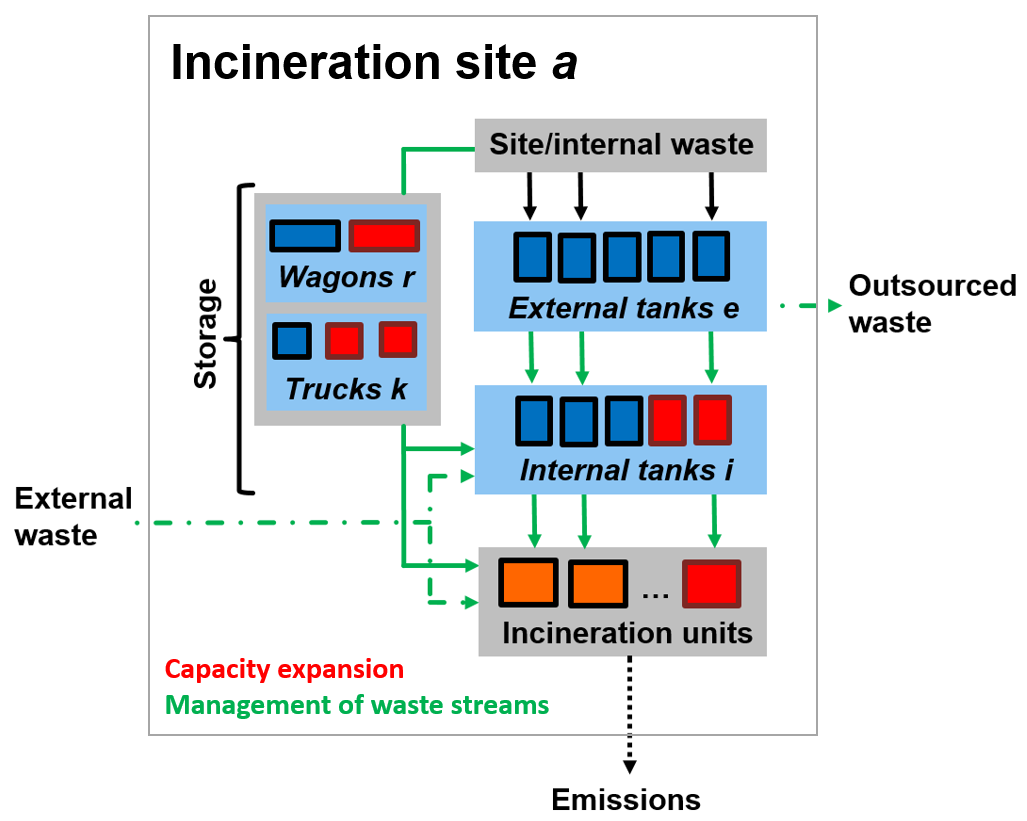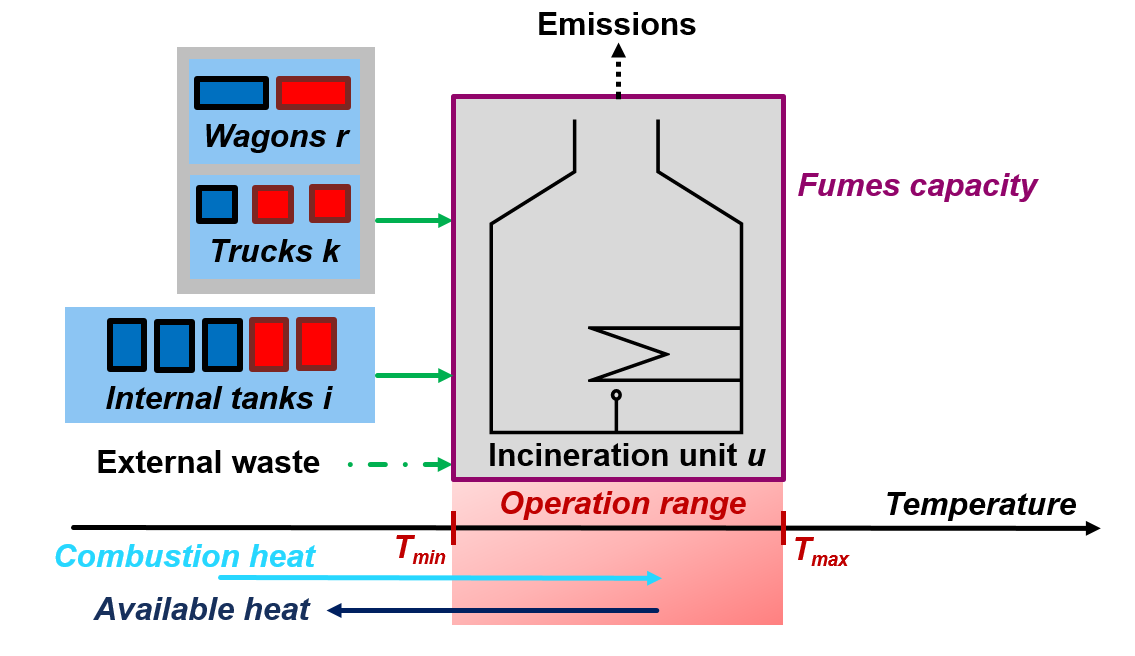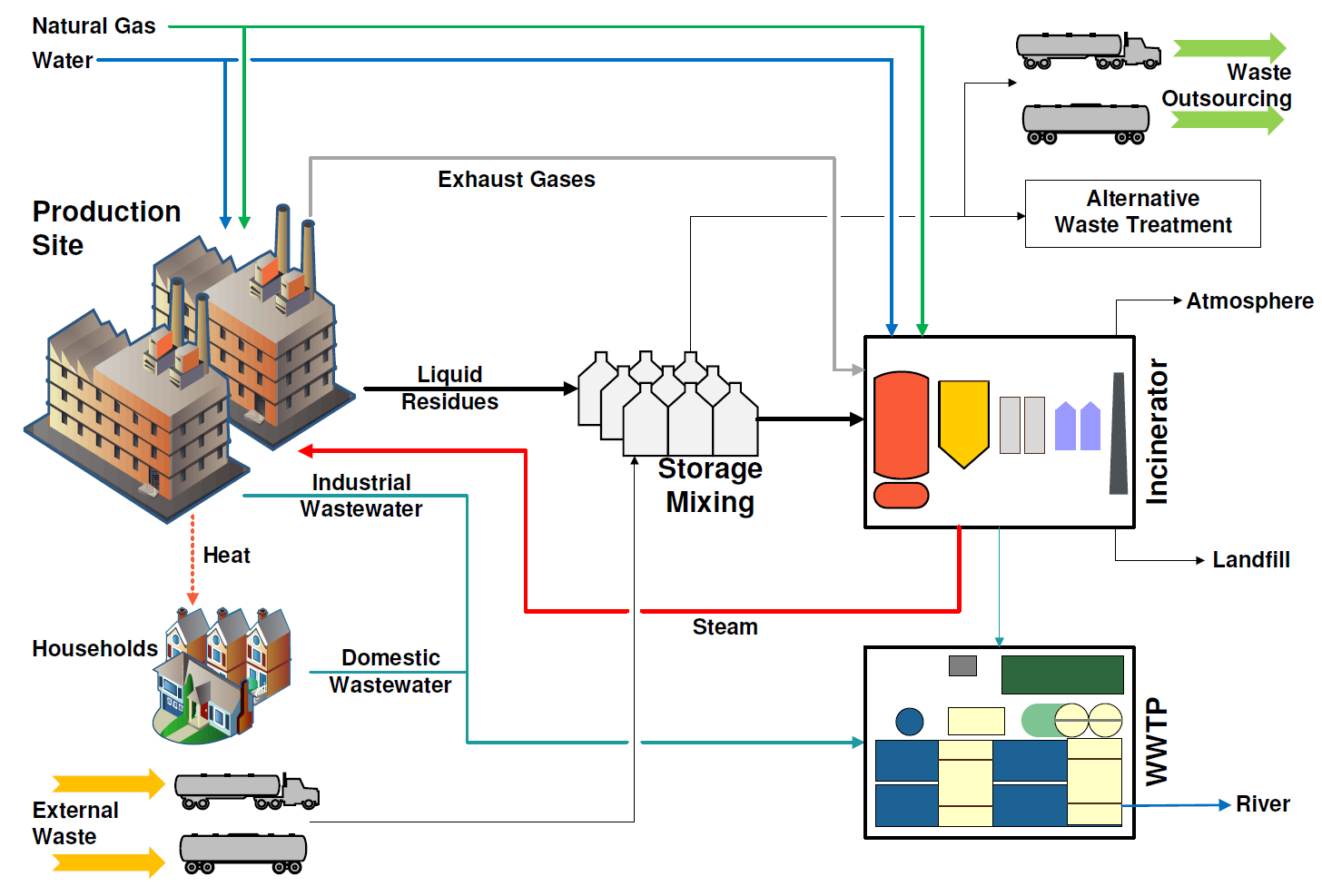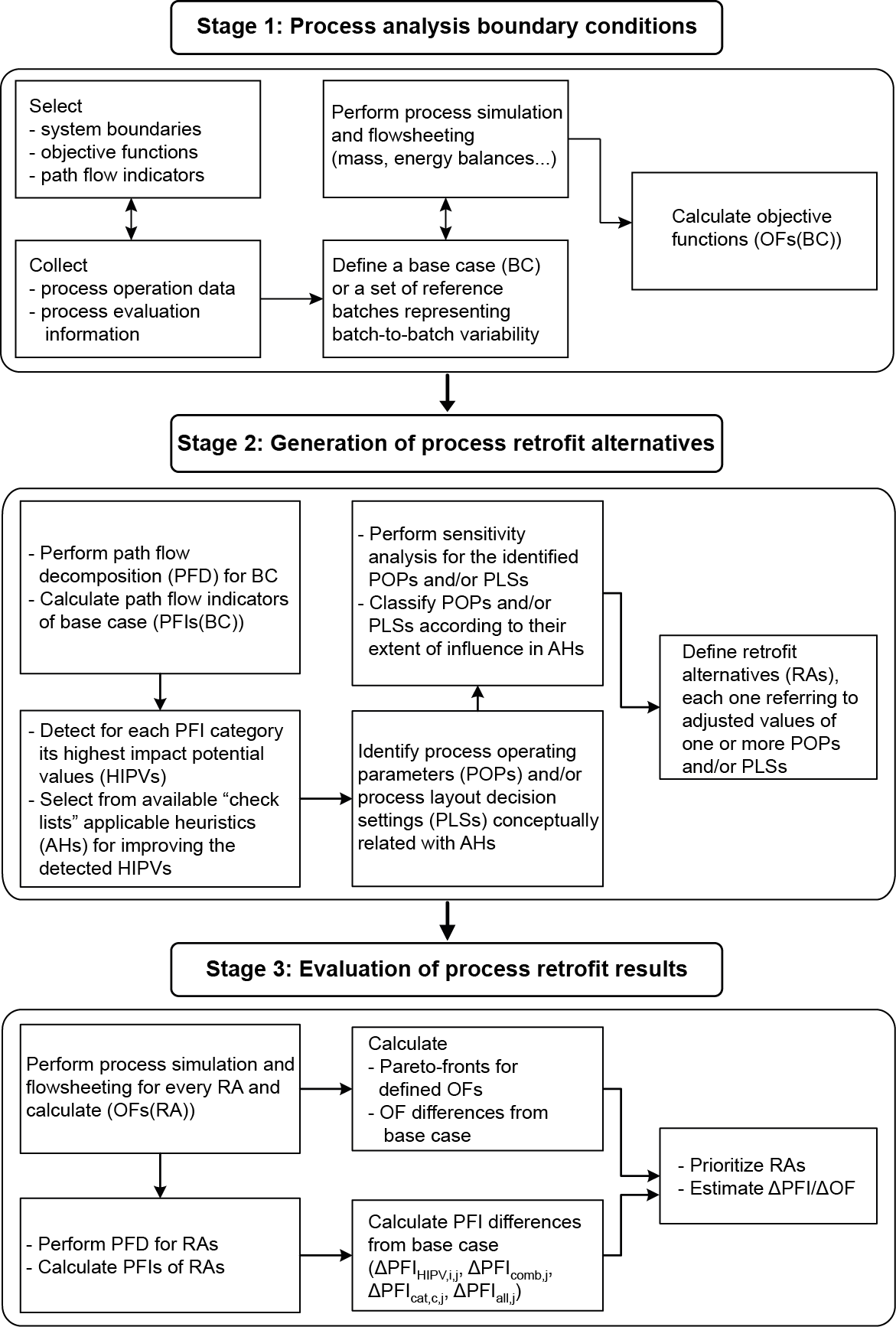Projects
Vasco Bolis, Elisabet Capón García, Konrad Hungerbühler
Overview
Increasing pressure to diminish the dependence on non-renewable sources creates a complex future scenario for the chemical and process industry. Proper management of waste incineration stands for an efficient strategy to decrease the consumption of primary energy sources in an integrated chemical site by recovering part of the combustion heat. The goal of this project is to provide and apply practical tools for facilitating the decision-making in management of industrial waste-to-energy networks and resource recovery systems. Key criteria concern fulfilling treatment requirements for the generated waste streams based on the relevant treatment capacities under technical, logistical and regulatory constraints, as well as improving the overall flexibility to deal with operational uncertainty. The project combines supply chain logistics, site management, and process operation of industrial waste-to-energy systems to optimize the contribution of the entire Swiss industrial waste-to-energy network to the energy turnaround.
Systematic modelling and optimisation are the two main approaches used in this work for tackling the waste management and plant integration problems. Systematic modelling pursues the adequate representation of the elements comprised in industrial waste management and resource recovery systems, whereas optimisation-based techniques aim at the application of algorithms for solving the posed problems to obtain optimal solutions under relevant constraints. The resulting strategies are tested on four industrial case studies, conducted in collaboration with the industry.
Keywords
Energy efficiency; waste management; systems analysis; design; optimisation; scheduling; planning; sustainability assessment
Collaborations
- CIMO SA, Monthey
- Dottikon Exclusive Synthesis AG, Dottikon
- Geocycle, Holderbank
- Holcim Schweiz AG, Zürich
- Infrapark Baselland AG, Muttenz
- Lonza AG, Visp
- Verband der Betreiber Schweizerischer Abfallverwertungsanlagen (VBSA), Bern
- Swiss Federal Office for the Environment, Bern
Affiliations
- external page National Research Programme NFP 70 “Energy Turnaround”, Swiss National Science Foundation
- external page Academic joint collaboration wastEturn (within the NFP 70)
Contributions
- Teresa Rodríguez Hernández, Strategic long-term optimisation of industrial waste-to-energy systems, Master student (semester project)
- Nicola Dal Pian, Strategic long-term optimisation of industrial waste-to-energy systems, Master student (research project)
- Oliver Weder, Data analysis and model development for the Swiss industrial waste-to-energy perspective, Research assistant
- Marta Roca Puigròs, Data analysis and model development for the Swiss industrial waste-to-energy perspective, Research assistant
- Aline Gazzola, Data analysis and model development for the Swiss industrial waste-to-energy perspective, Research assistant
- Nicola Dal Pian, Robust Long-Term Optimization of Industrial Waste-to-Energy Networks under Uncertain Conditions, Master student (thesis)
- Agostino Dall’Ara, Development of Solution Strategies for Computationally Intensive Optimization Problems in Industrial Waste Incineration Management, Master student (thesis)
Publications
Vasco Bolis, Elisabet Capón-García, Konrad Hungerbühler (2016): Optimal Design of Industrial Waste-to-Energy Networks, 26th European Symposium on Computer Aided Process Engineering (ESCAPE), Conference Proceedings, 2016
Conferences
- Vasco Bolis, Elisabet Capón-García, Konrad Hungerbühler (2016): Optimal Design of Industrial Waste-to-Energy Networks, ESCAPE 26, Portorož (Slovenia), Poster presentation
- Vasco Bolis, Elisabet Capón-García, Konrad Hungerbühler (2017): Optimal Design of Multi-Enterprise Industrial Waste-to-Energy Networks, ESCAPE 27, Barcelona (Spain), Poster presentation
- Vasco Bolis, Elisabet Capón-García, Konrad Hungerbühler (2017): Optimal Design of Multi-Enterprise Industrial Waste-to-Energy Networks Under Uncertain Conditions, 2017 AIChE Annual Meeting, Minneapolis (US), Oral presentation
Matteo Abächerli, Elisabet Capón García, Konrad Hungerbühler
Overview
In-house waste treatment in the chemical industry brings many advantages but also some risks. It is crucial e.g. to guarantee through clever planning and scheduling a quick and efficient disposal of the waste to avoid holdups in the production. Current trends in process industry highlight the importance of improving decision-making processes at each level in a company.
Planning and scheduling problems concerning/dealing with waste treatment in an industrial context are large sized problems and thus/consequently quite complex to tackle. In the field of waste treatment, little research at industrial level has been done so far. In industry, planning and scheduling of complex processes is often purely based on empirical decisions. Therefore, the optimization potential is quite large as modern tools allow to obtain solutions able to cope with existing challenges more effectively.
The project aims at providing systematic tools to the industry, combining planning and scheduling levels, in order to improve both decision-making processes and the overall company's flexibility to respond to uncertainty in the waste management problem.
The main objectives of the project can be formalized as follows:
- To improve existing scheduling and planning models, and formulate case-specific models in order to deal effectively with non-trivial features of waste treatment processes.
- To integrate process models within scheduling and planning formulations, considering different levels of detail.
- To propose methodologies extending the functional scope of the planning and scheduling problem, and allow to assess several objectives, such as economic, safety and environmental ones.
- To present reactive strategies for dealing with the scheduling problem under uncertainty.
- To propose algorithms and optimization strategies able to cope with large-size problems.
Keywords
Industrial waste incineration, waste-to-energy, Process planning & scheduling, Optimization, Mathematical modelling
People involved
Stavros Papadokonstantakis, Aline Gazzola, Daniel Santos, Philipp Steinleitner, Oliver Weder, Samuel Perren and Ralph Bannerman
Collaborations
Lonza AG, Visp
Commission for Technology and Innovation (CTI) - Federal Department of Economic Affairs, Education and Research (EAER)
Publications
Abaecherli, M. L., Santos, D.; Capón-García, E. and Hungerbühler, K. (2016): Mathematical Optimization of Real-time Waste Incineration Scheduling in the Industry, Computer Aided Chemical Engineering, Volume 38, Pages 13-18
Presentations
Abaecherli, M.; Capón-García, E.; Papadokonstantakis, S. and Hungerbühler, K. (2014): Natural Gas Reduction in Industrial Waste Incineration by Optimized Short-Term Scheduling, Industrial Applications in Design and Operations. Conference Proceedings of AIChE Annual Meeting, Atlanta, Georgia, USA
Abaecherli, M.; Capón-García, E. and Hungerbühler, K. (2015): Reduction of the Environmental Impact While Improving the Economic Benefits: A Win-Win Situation in Industrial Waste Incineration through Optimized Treatment Schedules. 4th International Congress on Sustainability Science & Engineering, Balatonfüred, H
Abaecherli, M.; Steinleitner, P.; Capón-García E. and Hungerbühler, K. (2015): Rolling-Horizon Approach for Improved Industrial Waste Incineration Scheduling. Energy conservation & management, 10th European Congress of Chemical Engineering, Nice, F
Abaecherli, M.; Perren, S.; Capón-García E. and Hungerbühler, K. (2016): Integration of Hierarchical Waste Incineration Scheduling Levels for Improved Industrial Performance, Process operation and optimization, PSE Asia, Tokyo, J
Posters
Bannerman, R.; Abaecherli, M. L.; Capón-García, E. and Hungerbühler, K. (2015): Handling Forecast Uncertainty in Industrial Waste Incineration Scheduling, Catalysis Sciences & Engineering, SCS Fall Meeting, Lausanne, CH
Perren, S., Abaecherli, M. L.; Capón-García, E. and Hungerbühler, K. (2015): Integration of Hierarchical Waste Incineration Scheduling Levels for Improved Industrial Performance, Catalysis Sciences & Engineering, SCS Fall Meeting, Lausanne, CH
Weder, O., Abaecherli, M. L.; Capón-García, E. and Hungerbühler, K. (2015): Improved Solution Finding in Industrial Waste Incineration Scheduling Through Implementation of Multi-Objective Strategies, Catalysis Sciences & Engineering, SCS Fall Meeting, Lausanne, CH
Abaecherli, M. L., Santos, D.; Capón-García, E. and Hungerbühler, K. (2016): Mathematical Optimization of Real-time Waste Incineration Scheduling in the Industry, CAPE/PSE in Sustainable Energy Applications, ESCAPE26, Portorož, SLO
Lukas Eberle, Elisabet Capón García, Stavros Papadokonstantakis, Andreas Graser, Hirokazu Sugiyama, Rainer Schmidt, Konrad Hungerbühler
Enhancing Efficiency of Liquid Drug Product Manufacturing: Data-driven Methodologies and Industrial Application
Overview
For two reasons, enhancing the efficiency of liquid drug product manufacturing is increasingly important for pharmaceutical companies. On the one hand side, shrinking research productivity and increasing competition from non-innovative companies motivate improvements. On the other hand side, the swift improve to production data availability enables the application of rational, data-driven methodologies.
The development and application of such methodologies was the goal of this project which was split in four independent tasks. First, liquid drug product manufacturing was assessed end-to-end with regard to process inefficiencies and production yield improved substantially. Second, a key loss (scratched vials) was investigated in more detail and innovative approaches to the reduction of mechanical damages to glass surfaces presented. Third, lead time was analyzed, key processes driving the lead time assessed by sensitivity analysis and then reduced based on forecasts gained with the support of Monte Carlo simulations. Fourth, production processes were modelled mathematically and optimization potentials of up to 8 % on makespan revealed in industrial case studies.
The project takes advantage of the extensive data recordings in the pharmaceutical industry, which result from the requirements of health authorities. For increasing accessibility or availability of data at the beginning of this project, individual databases were consolidated to a single Manufacturing Intelligence Solution (MIS).
Keywords
MIS (management information system), decision making, pharmaceutical manufacturing, scheduling, optimization, yield, data analysis, statistical process control, lead time
Collaborations
- F. Hoffmann-La Roche Ltd.
- The University of Tokyo
Contributions
- Martin Senninger: A Mixed Integer Linear Programming (MILP) Scheduling Optimization Approach for Pharmaceutical Manufacturing (Master thesis)
- George Tien: Increasing plant productivity through optimal batch scheduling in the pharmaceutical industry (Master thesis)
Publications
L. Eberle, H. Sugiyama, S. Papadokonstantakis, A. Graser, R. Schmidt, and K. Hungerbühler: Data-driven tiered procedure for enhancing yield in drug product manufacturing, Computers and Chemical Engineering, (2016) Elsevier Ltd., external page DOI
Eberle, L; Capón García, E; Sugiyama, H; Graser, A; Schmidt, R; Hungerbuhler, K.: Rigorous Approach to Scheduling of Sterile Drug Product Manufacturing, Computers & Chemical Engineering, submitted, 2016.
Eberle L.; Sugiyama H.; Papadokonstantakis S.; Graser A.; Schmidt R.; Hungerbühler K.: Improving Pharmaceutical Batch Production Processes with Data-Based Tiered Approach, Computer Aided Chemical Engineering, 34, 1967-1972; 2015. external page DOI
Eberle L.; Capón-Garcia E.; Senninger M.; Sugiyama H.; Graser A.; Schmidt R.; Hungerbühler K.: Optimal Scheduling of Liquid Drug Product Manufacturing;Computer Aided Chemical Engineering, 34, 2033-2038; 2015. external page DOI
Eberle, L; Sugiyama, H; Schmidt, R.: Improving lead time of pharmaceutical production processes using Monte Carlo simulation; Computers & Chemical Engineering, 68, 255-263; 2014. external page DOI
Eberle L.; Sugiyama H.; Papadokonstantakis S.; Graser A.; Schmidt R.; Hungerbühler K.: Data-Based Tiered Approach for Improving Pharmaceutical Batch Production Processes; Computer Aided Chemical Engineering, 33, 463-468; 2014.
Eberle L.; Sugiyama H.; Schmidt R.: Improving Lead Time of Sterile Drug Product Manufacturing Using Monte Carlo Simulation; Computer Aided Chemical Engineering, 32, 685-690; 2013.
Conferences
7th International Symposium on Design, Operation and Control of Chemical Processes (PSE ASIA) 2016, oral presentation: Data-driven approach for increasing yield in drug product manufacturing, Tokyo, Japan
American Institute of Chemical Engineers (AIChE) 2015, oral presenation: Modelling Liquid Drug Product Manufacturing: Method and Case Study', Salt Lake City, United States of America
AIChE 2015, oral presenation: Improving Yield of Drug Product Manufacturing with Hybrid Approach, Salt Lake City, United States of America
European Symposium on Computer Aided Process Engineering (ESCAPE) 2015, oral presentation: Optimal Scheduling of Liquid Drug Product Manufacturing, Copenhagen, Denmark
ESCAPE 2015, poster presentation: Improving Pharmaceutical Batch Production Processes with Data-Based Tiered Approach, Copenhagen, Denmark
ESCAPE 2014, oral presentation: Data-Based Tiered Approach for Improving Pharmaceutical Batch Production Processes, Budapest, Hungary
QP-meets-IT Systec and Services 2014, oral presentation: Datenbasierte Prozess-Optimierungen in der Parenteraliaproduktion, Karlsruhe, Germany
ESCAPE 2013, Poster: Improving Lead Time of Sterile Drug Product Manufacturing Using Monte Carlo Simulation, Lappeenranta, Finland
Merten Morales, Stavros Papadokonstantakis, Konrad Hungerbühler
Overview
The Wood2CHem project is a cooperation between the ETH Zurich and the EPF Lausanne and is funded by the Swiss National Science Foundation (SNF). Furthermore the project is part of the Swiss National Research Programme "Resource Wood" (NRP 66), which aims to establish basic scientific knowledge and practical methods for increasing the availability of wood as a resource and expanding its use in Switzerland.
The goal is to develop a computer aided platform to analyse different biorefinery concepts. The platform will do the process design and optimization simultaneously under ecological or economic aspects (e.g. Process Integration, Life Cycle Analysis). The goal of the Wood2CHem tool is to find the best biorefinery design for wood into marketable products and energy services under predefined constraints.
Sara Badr, Stavros Papadokonstantakis, Konrad Hungerbühler
Sustainability metrics and guidelines for the analysis of solventbased post-combustion CO2-capture process alternatives
Overview
The project will provide a list of suitable sustainability metrics and guidelines, covering “cradle-to-gate” Life Cycle Impact Assessment (LCIA) and “gate-to-gate” identification of Safety, Environmental and Health (SHE) hazards. This will be achieved by an exhaustive screening of available sustainability indicators and frameworks, “green chemistry and engineering” principles, and early process design heuristics and methodologies. It is intended to develop systematic methodologies for the extraction of a non-redundant, comprehensive list of suitable metrics and guidelines, specially tailored for the assessment of solvent-based post-combustion CO2-capture processes at the level of basic design. Particularly challenging tasks will be the estimation of environmental impacts for the supply chains of novel solvents and of intrinsic SHE dangerous properties in the presence of data gaps.
This project is part of the collaborative EU-project (FP7) “CAPSOL: Design Technologies for Multi-scale Innovation and Integration in Post-Combustion CO2 Capture: From Molecules to Unit Operations and Integrated Plants”.
Filippo Marchione, Stavros Papadokonstantakis, Konrad Hungerbühler
Integrating "green" process engineering principles into advanced flowsheet decomposition and design techniques
Improvement of existing chemical processes, also called retrofitting, has gained much attention in industry due to the competitive market and stricter environmental legislation. Especially in batch processes retrofitting is of high importance as constantly shortened time-to-market periods require the facility to be optimized after the production has started. Therefore, methodologies to systematically investigate and retrofit batch processes are needed in order to effectively generate and evaluate promising retrofit alternatives. Furthermore the evaluation of industrial case studies is required in order to illustrate the applicability of such methodologies.
The goal of this research project is to present a systematic retrofit methodology based on process flowsheet decomposition and path flow indicators which can highlight process improvement potential and guide through alternatives with improved process performance. The systematic retrofit methodology consists of three stages.
In the first stage the base case scenario is defined and the objective functions of the base case(s) are calculated, which serve as reference in the next stages. The second stage comprises a procedure that systematically generates promising retrofit alternatives for the respective base case(s). In the last stage of the methodology the retrofit alternatives are classified and prioritized. The objective is not restricted to economic process improvement as ecological aspects related to the process energy consumption are also investigated and Pareto-analysis is conducted.
Keywords
retrofit method, path flow indicators, chemical batch process, sustainable process alternatives
Publications
A. A. Bumann, S. Papadokonstantakis, U. Fischer, K. Hungerbühler: Evaluation and analysis of a proxy indicator for the estimation of gate-to-gate energy consumption in the early process design phases: The case of organic solvent production. Energy 2010; 35: 2407-2418. external page DOI
A. A. Bumann, S. Papadokonstantakis, U. Fischer, K. Hungerbühler: Optimization of chemical batch processes within a systematic retrofit framework including evaluation of historical process data. Chemical Engineering Transactions 2010; 21: 919-924. external page DOI
A. A. Bumann, S. Papadokonstantakis, U. Fischer, K. Hungerbühler: Investigating the use of path flow indicators as optimization drivers in batch process retrofitting. Computers and Chemical Engineering, 2011; 12: 2767-2785. external page DOI




